






The study of musical instruments (’organology’ – no, really) is the study of the human condition. Every culture is defined by its own distinctive set of trills, whistles, parps, honks and beats, and every corner of the world has evolved its own location-specific indigenous instrument to renew a sense of cultural identity through noisy self-expression. And instruments evolve – never more so than now, in the midst of a technological revolution that has opened up entirely new ways to make music. So settle back and compose yourself as we look at ten new instruments that look set to accompany us into the world of tomorrow.
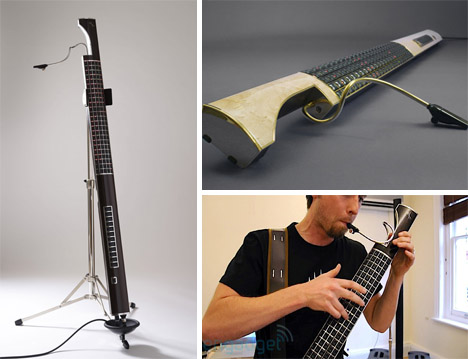
In development for 8 years with funding of over £10m / $16.5m, the Eigenharp is a slow-crafted technological marvel. 120 keys (each one tilting to give a flexible tone), percussion buttons, built-in sound management capabilities including recording, playback and looping, and a potentially limitless range of noises thanks to running on uploaded digitally sampled sounds. It is played via keyboard, tap-pad and mouthpiece – and the result is an instrument that sounds like a band.
http://www.youtube.com/watch?v=zcVqJh0qEMc&feature=player_embedded
Similarly digitally enhanced are the electric violins, a family of new hybrid instruments that are sufficiently well-established to become a mainstay of the modern music scene. Thanks to electrical pickups inside or outside the instrument’s body, the violin’s vibrations are run through electronic processing and transformed into any sound under the sun – most effectively, the noise of an electric guitar. Witness the magic of Ed Alleyne-Johnson performing on the streets of Chester, England.
http://www.youtube.com/watch?v=vUO6kYLb6As&feature=player_embedded

No, this isn’t the first good-to-go version of Minesweeper: this baby is for making beautiful music with. The 16 x 16 grid of LED lights on the Tenori-On responds to touch and to real-time looped programming, creating soaring, rippling compositions that mesmerise beginners and experts alike (Peter Gabriel is a fan). If you want a hands-on demonstration of its power, try Andre Michelle’s ToneMatrix, an online AudioTool-powered simulation.
http://www.youtube.com/watch?v=_SGwDhKTrwU&feature=player_embedded

Musical instrument or chest expander? You’d be forgiven for asking – but the Samchillian is a new, ergonomic-minded take on the keyed instrument, with each key representing a relative, not fixed, note. As the musician plays, the function of each part of the instrument is constantly changing, allowing a full range of musical expression (provided the player has a really good memory, of course).
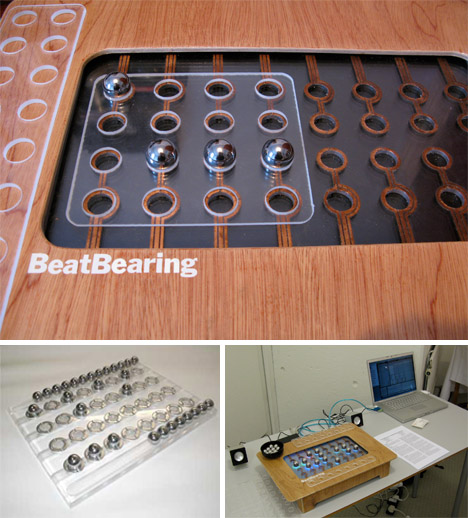
And moving further into the realm of instruments that look like anything but – we have the BeatBearing. Instead of generating noise itself, the BB triggers the timing of preselected types of percussion – simply drop a steel ball-bearing in the right slot to get the beat you want, when you want. The inventor isn’t interested in manufacturing his design: instead, he has published the plans on DIY-tech online magazine MakeZine to encourage people to build their own - and with more than 1 million views of the Youtube demo (below) at the start of this year, we reckon there will be plenty of takers.
http://www.youtube.com/watch?v=wreP8FMupyM&feature=player_embedded
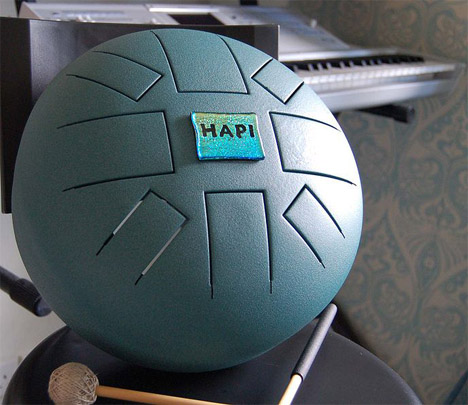
At least the Hapi looks like what it is (well, kinda) – a steel drum with a hole in the base that allows the player to control the amount of noise emerging, using their lap. Since each key (or “tongue”) is part of the main body of the instrument, each note is accompanied by a subtle resonant harmony from other musically compatible notes. Time for a demonstration, methinks…
http://www.youtube.com/watch?v=PW-GZ05htLE&feature=player_embedded
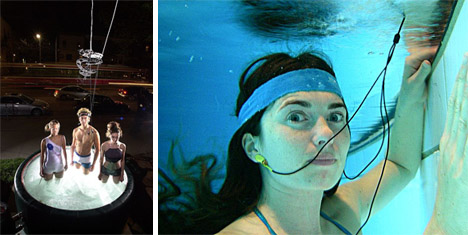
At first sight, you’re looking at a lady trying to listen to her iPod underwater, and a collection of buff young people stood up in a hot-tub. In fact in both pictures depict music-making, via an electroencephalophone – a device that converts brainwaves into sound (and therefore a quintephone). The lady is psychotherapist Ariel Garten participating in a concert performance – and the “hot-tub” trio are an electroencephalophonist and two assistants accompanying on electrocardiophones.
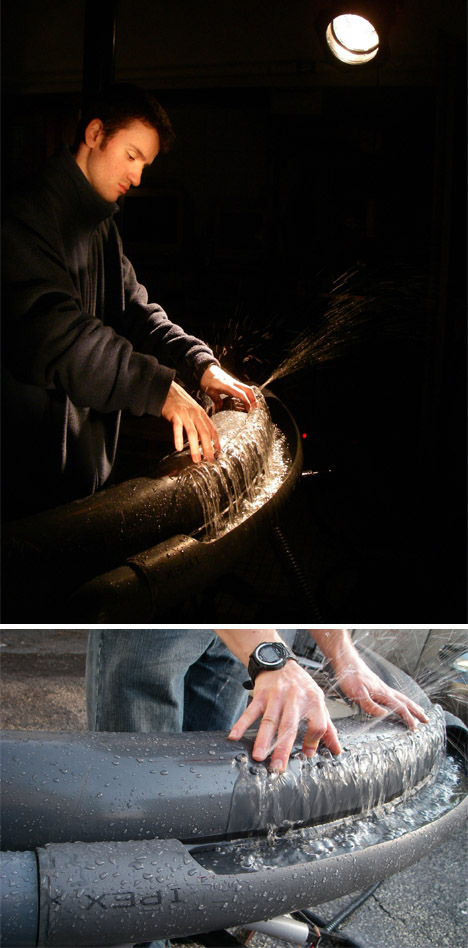
Now to the merry, messy world of the hydraulophones. Water flows out holes in the instrument, and the player uses his fingers to block or divert each stream, triggering internal mechanisms – discs, shafts or valves – that produce sound. In other words, it works like a woodwind instrument, except the wind is replaced by water (which doesn’t directly create the sound).
http://www.youtube.com/watch?v=tnJb9WyhCUc&feature=player_embedded#
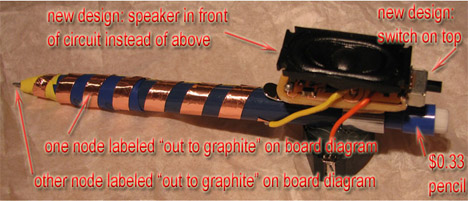
Daring you to not burst out laughing when it gets underway is the Drawdio, a homespun theramin. There are a number of ways to make one (cheaply and easily), but the working principle remains the same in all models – it runs a current through the graphite deposited from the end of your pencil (or any other appropriate medium, including yourself), and translates it through a synthesizer to create a noise like a kazoo in a gale.
http://www.youtube.com/watch?v=PV_w38ldZaE&feature=player_embedded
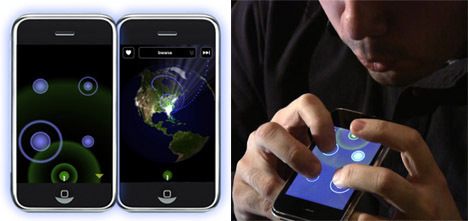
But for breadth of lateral thinking, hats off to Smule, the inventors of the Ocarina iPhone application. Using the phone’s built-in movement sensors and touch screen, your phone becomes either a wholly keyed instrument…or a kind of flute, by detecting the passage of your blown breath and translating it into intensity of sound. Once you’ve finished your piece, upload it to the Ocarina online community and listen to the work of others. A virtual instrument that automatically shares its output online – can you get more contemporary than that?
http://www.youtube.com/watch?v=RhCJq7EAJJA&feature=player_embedded
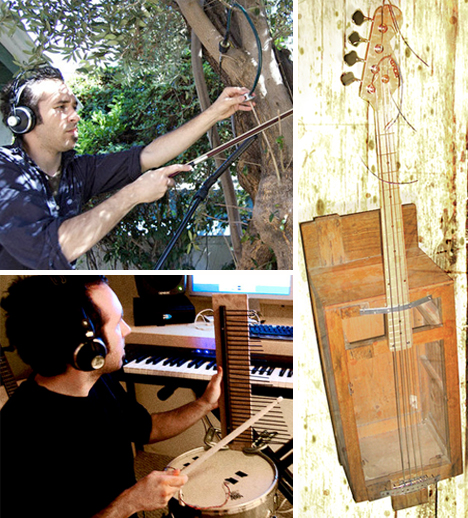
It’s hard to keep your wits about you when you step into Diego Stocco’s world. It’s a world parallel to our own, with one notable difference: absolutely everything is made of music. Everything from sand to cereal to fire to a tree can produce enthralling sounds. When in Diego’s capable hands, every item in view is just music waiting to happen. And chances are that if you’ve watched television, seen movie trailers, or played video games in the last several years, you’ve already heard some of his work.
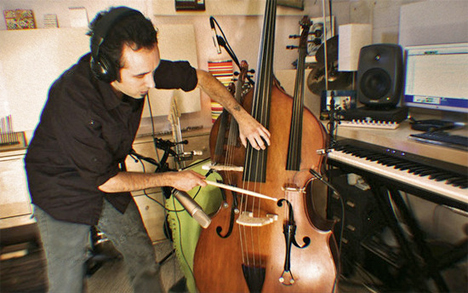

What’s most surprising about Deigo isn’t necessarily the sounds that he creates or the items that he uses to create them; it’s his enthusiasm for the process. Reading his own descriptions of his projects and watching the videos of him at work, it’s easy to get swept up in his excitement. He seems to treat every new instrument as though it were his first, never losing the awe and curiosity that led him to make “imaginary sounds” in the first place.
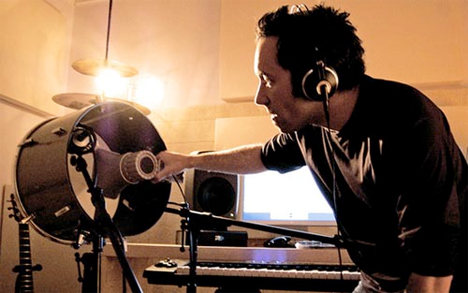
The amazing thing about Stocco’s music is that he is a master sound engineer, and even if you know what you’re listening to it’s hard not to separate the origin of the sound from the finished product: a stapler spring no longer sounds like a stapler spring, but an elegant and playful instrument. Fingers running across sand become a sophisticated percussion section. Corn Flakes become a surprisingly wonderful accompaniment to haunting piano pieces. Sounds that would be odd and disjointed in any other situation become the melody and highlights of incomparably beautiful compositions.
http://www.youtube.com/watch?v=jdYj7dMYwxM&feature=player_embedded
Diego doesn’t limit himself to simply playing everyday objects as instruments, though. You might call him the Dr. Frankenstein of musical instruments
http://vimeo.com/1747614
Diego Stocco – The Burning Piano from Diego Stocco on Vimeo.
Luckily, there are plenty of ways to find Diego Stocco’s work online – and he’s constantly making more. Check out his Behance portfolio here for pictures, audio samples, and videos. Visit his official site for news, more audio and videos, and some information about the artist himself. Check out even more music samples on his Band Camp page. Spend a day walking around in Stocco’s world and you’ll never look at your washing machine, backyard trees, or breakfast cereal in the same way again.

Most music lovers can agree that music doesn’t always follow the rules. Some of the most beautiful melodies have come from artists who chose to do their own thing despite conventional wisdom. The same is true for artists who create new instruments. Where would modern music be without the “crazy” instruments and techniques invented and modified over the years? These instruments are among the most innovative, the most creative, and the most bizarre out there.
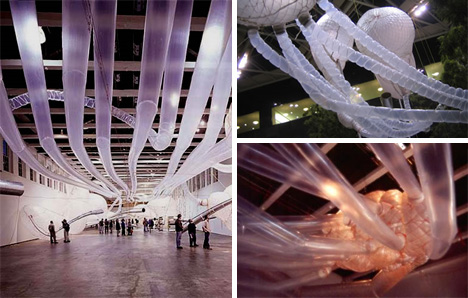
When Los Angeles artist Tim Hawkinson toured around the country with a massive indoor sculpture, he caused big reactions from just about everyone who saw it. Many of them wondered just what it was, and they can be forgiven for not understanding immediately. After all, the 300-foot long sculpture was comprised largely of 13 bus-sized inflated bags and was simultaneously organic and alien. But when it started playing, it was obvious: the Uberorgan was a massive musical instrument. The entire assembly looked like massive ethereal jellyfish suspended in mid-air, but operated like the giant lovechild of a bagpipe and a pipe organ. A visual sensor “read” notes from a scrolling 200-foot-long roll of Mylar to entertain viewers with a score he composed just for the Uberorgan.
http://www.youtube.com/watch?v=POCdAZdDWuw&feature=player_embedded
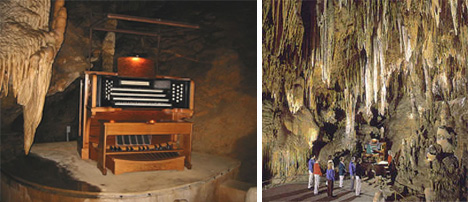
The world’s largest instrument resides in a cave in Virginia, and the music it produces is both earthy and otherworldly. The Great Stalacpipe Organ was created in 1954 after Pentagon scientist Leland W. Sprinkle noticed that the stalactites in Luray Caverns produced resonating notes upon being struck. He spent three years tuning stalactites to precise pitches – with sandpaper. He then wired rubber mallets to strike the stalactites when corresponding keys are depressed on the organ’s keyboard. The organ still plays today for visitors to Luray Caverns.
http://www.youtube.com/watch?v=7ys5fdrsAUM&feature=player_embedded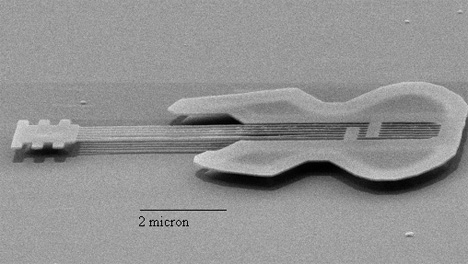
If you thought playing a ukulele was hard, try plucking this tiny guitar. It’s a six-string guitar made of crystalline silicon, and it’s no bigger than a single cell. Each string is 50 nanometers wide: the width of 100 atoms. Researchers at Cornell University created it in 1997 to showcase emerging technology for manufacturing a new generation of electronics. Though it can technically be played (if you happen to have access to an atomic force microscope), the 10 micrometer-long instrument would only resonate at inaudible frequencies.

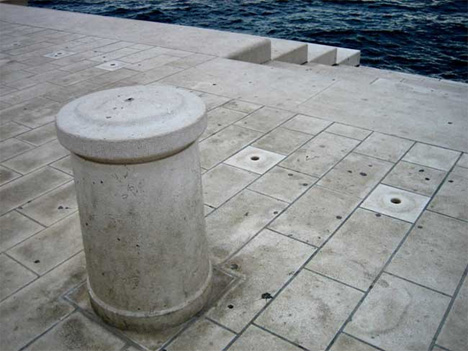
Visitors to the sea front in Zadar, Croatia used to be greeted by grim, ugly concrete walls. But since the public unveiling of the Sea Organ in 2005, visitors have been able to visit the sea front to enjoy the music of nature. The Sea Organ is a musical instrument that consists of 35 musical tubes with openings on the above concrete stairs. Movement of the sea’s waves pushes air through the openings, creating incredible chords and dissonant tunes. Similar instruments exist in San Francisco and Blackpool, but Zadar’s version can be heard more consistently and has done wonders for the tourist trade in the area.
http://www.youtube.com/watch?v=pQ9qX8lcaBQ&feature=player_embedded

Thought to be the only orchestra in the world using nothing more than vegetable instruments to make music, the Vienna Vegetable Orchestra has been performing around the world since its formation in 1998. Its members carve, cut and tweak fresh produce to create a multisensory musical experience. Their instruments are made fresh right before every performance, and after they wow audiences with their musical prowess their staff cook makes a delicious vegetable soup from some of the vegetables – hopefully not the parts the musicians have been blowing into. Just don’t ask the orchestra members if they’re all vegetarians; they’re tired of hearing that question over and over.
http://www.youtube.com/watch?v=hpfYt7vRHuY&feature=player_embedded

